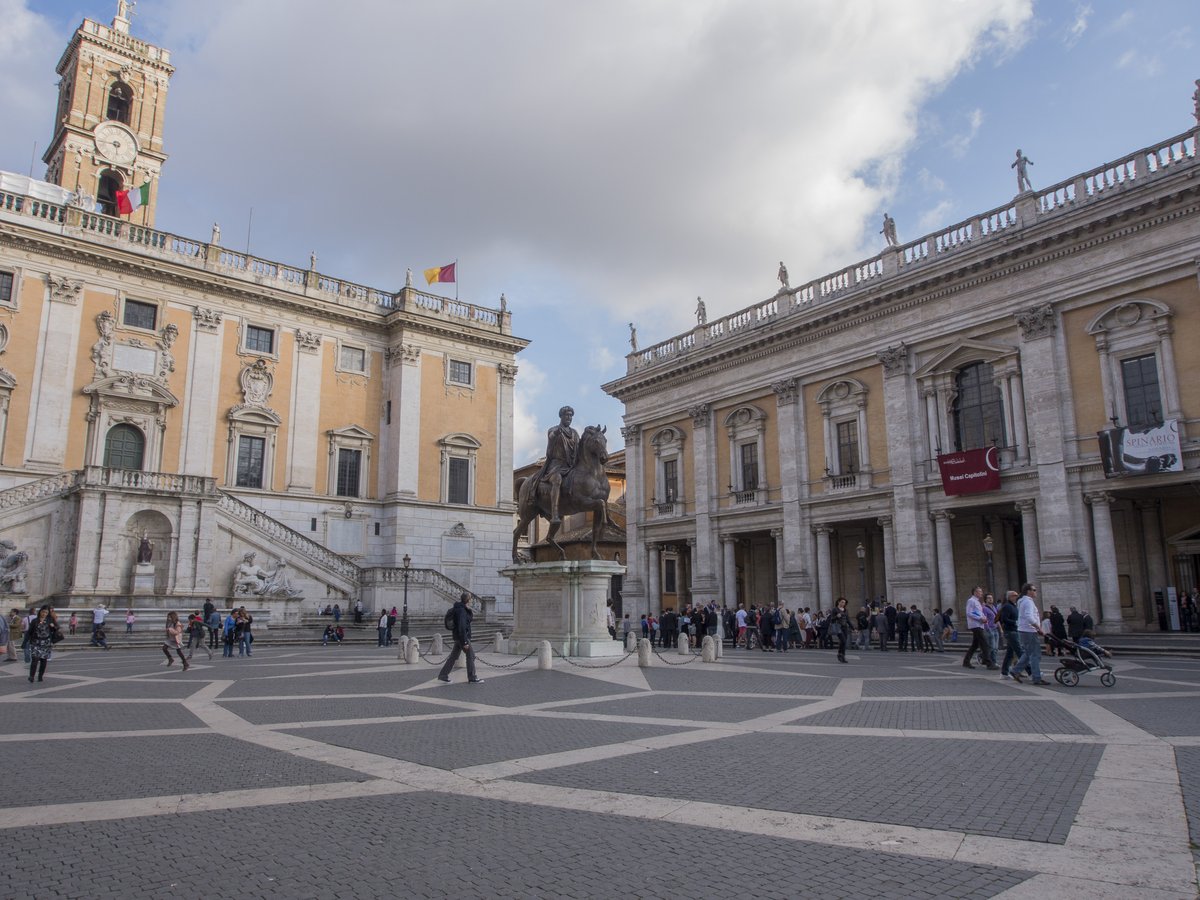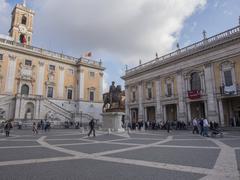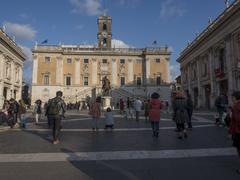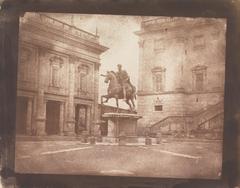
Piazza del Campidoglio: Visiting Hours, Tickets, and Historical Highlights in Rome
Date: 14/06/2025
Introduction to Piazza del Campidoglio
Piazza del Campidoglio, situated atop Rome’s Capitoline Hill, is a masterpiece of Renaissance urban design and a symbol of the city’s enduring civic identity. Redesigned by Michelangelo in the 16th century, the square bridges ancient Roman heritage, Renaissance innovation, and modern municipal life. Its unique trapezoidal layout, starburst pavement, and ensemble of monumental buildings—including the Palazzo Senatorio, Palazzo dei Conservatori, and Palazzo Nuovo—make it a must-see for history enthusiasts, art lovers, and travelers alike.
This guide provides detailed information on the piazza’s history, architectural significance, visiting hours, ticketing, accessibility, and tips for planning a memorable visit. For the latest visitor updates, consult the official Capitoline Museums website and Rome’s tourism portal.
Historical Background
Ancient Origins and Early Significance
Capitoline Hill has been a focal point of Roman life since the Bronze Age, with archaeological evidence of early settlements and religious activity (archeoroma.org). In antiquity, the hill hosted major temples, most notably the Temple of Jupiter Optimus Maximus, and was the symbolic heart of Rome’s religious and political life. The area played a central role in triumphal processions and key civic rituals, with all roads in ancient Rome said to converge here (barcelo.com).
Medieval Decline and Transformation
Following the fall of the Western Roman Empire, the Capitoline’s significance waned. Temples fell into ruin, and the area became known as “Monte Caprino” (Goat Hill) due to its use as pastureland (en.wikiarquitectura.com). Despite this decline, the Capitoline retained some administrative importance; the Palazzo Senatorio, built atop the ancient Tabularium, became Rome’s city hall in the 12th century (archeoroma.org).
Renaissance Revival and Michelangelo’s Vision
The transformation of the Capitoline Hill began in the 16th century, when Pope Paul III commissioned Michelangelo to redesign the neglected site in anticipation of Emperor Charles V’s visit (rome.us). Michelangelo’s radical plan reoriented the square toward St. Peter’s Basilica, symbolizing a shift from ancient pagan Rome to the city’s new Christian center (en.wikiarquitectura.com). His design introduced a harmonious arrangement of buildings, a grand processional ramp (the Cordonata), and a star-patterned pavement that unified the space (wga.hu).
Architectural and Artistic Innovations
Michelangelo’s design imposed geometric order on the irregular site, with the trapezoidal piazza and oval pavement drawing the eye toward the central equestrian statue of Marcus Aurelius. The facades of the palazzi were unified with giant pilasters, and the Cordonata provided dignified access from Piazza d’Aracoeli, flanked by ancient statues and crowned by the Dioscuri (rome.us). The star-shaped pavement, completed in the 20th century based on Michelangelo’s plans, is a defining feature of the square (archeoroma.org).
Later Developments and Modern Significance
The completion of Michelangelo’s vision spanned centuries, with the final pavement laid in 1940 (en.wikiarquitectura.com). Today, Piazza del Campidoglio remains the seat of Rome’s municipal government and is home to the Capitoline Museums, the world’s oldest public museum collection, showcasing treasures such as the original Marcus Aurelius statue and the Capitoline Wolf (rome.us).
Visiting Piazza del Campidoglio: Practical Information
Visiting Hours and Tickets
- Piazza del Campidoglio: Open to the public 24/7 and free of charge.
- Capitoline Museums: Open Tuesday to Sunday, 9:30 AM to 7:30 PM (last entry 1 hour before closing); closed Mondays and some public holidays.
- Tickets: Standard adult admission is approximately €15, with discounts for EU citizens aged 18–25 and free entry for children under 18. Advance booking is recommended, especially during peak seasons (official Capitoline Museums website).
Accessibility
The piazza is accessible via the gently sloping Cordonata ramp. Wheelchair users and those with mobility needs can access the museums via elevators and alternative entrances. The museums provide accessibility services; check the official website for details.
How to Get There
- Metro: Line B to Colosseo station; about a 10-minute walk.
- Bus: Multiple lines serve nearby stops, including 30, 81, and 87.
- Walking: Easily reachable from the Roman Forum and Piazza Venezia.
Best Times to Visit
Early mornings and late afternoons during weekdays offer a quieter atmosphere and optimal lighting for photography. Spring and autumn are ideal seasons for comfortable exploration.
Nearby Attractions
- Roman Forum and Palatine Hill
- Piazza Venezia and the Vittoriano
- Trajan’s Market and Column
- Jewish Ghetto
Guided Tours and Audio Guides
Guided tours and audio guides are available for both the piazza and the Capitoline Museums. These offer insightful historical context and help visitors appreciate the art and architecture on display.
Civic and Cultural Significance
Symbol of Roman Governance and Identity
Since antiquity, the Capitoline Hill has been the seat of Rome’s civic administration. The Palazzo Senatorio remains the city hall, and the piazza is a venue for official ceremonies and public events (archeoroma.org). The Capitoline Wolf statue, depicting Rome’s legendary founders, serves as an enduring symbol of the city.
In 1957, the Hall of the Horatii and Curiatii in the Capitoline Museums hosted the signing of the Treaties of Rome, marking the birth of the European Union (worldhistoryedu.com).
Architectural Harmony and Urban Innovation
Michelangelo’s design, with its trapezoidal plan and harmonious facades, set a precedent for Renaissance and Baroque urban planning (wikipedia). The starburst pavement and the orientation toward St. Peter’s Basilica symbolize the connection between Rome’s civic and spiritual centers.
The Capitoline Museums: Highlights and Visiting Tips
Founded in 1471, the Capitoline Museums are recognized as the oldest public museums in the world (worldhistoryedu.com). Housed in the Palazzo dei Conservatori and Palazzo Nuovo, the collections include:
- The original bronze Equestrian Statue of Marcus Aurelius
- The Capitoline Wolf
- The Dying Gaul
- The Capitoline Venus
- Works by Caravaggio, Bernini, and Rubens
Allow 2–3 hours for a thorough visit. The museums’ rooftop café offers panoramic views over the city.
Practical Tips for Visitors
- Tickets: Purchase in advance online to avoid queues (official website).
- Roma Pass: Consider for discounted entry to multiple attractions and free public transport (Lonely Planet).
- Dress Code: Comfortable shoes are recommended for cobblestone surfaces and stairs.
- Facilities: Restrooms are available inside the museums; nearby cafés and water fountains can be found in the surrounding area.
- Photography: Permitted in the piazza and most museum areas (no flash or tripods). The best photo spots are from the top of the Cordonata and the terrace behind Palazzo Senatorio.
Accessibility and Sustainable Tourism
Piazza del Campidoglio and the Capitoline Museums are committed to accessibility, with ramps, elevators, and services for visitors with disabilities (myromepass.com). Visitors are encouraged to respect the historic environment and participate in sustainable tourism by minimizing waste and avoiding damage to monuments.
Frequently Asked Questions (FAQ)
Q: What are the Piazza del Campidoglio visiting hours?
A: The piazza is open 24/7. The Capitoline Museums are open Tuesday–Sunday, 9:30 AM–7:30 PM.
Q: How much do tickets for the Capitoline Museums cost?
A: Standard adult tickets are around €15; discounts and free entry apply to eligible groups.
Q: Is the piazza accessible for wheelchairs?
A: Yes, with alternative routes and elevators in the museums.
Q: Are guided tours available?
A: Yes, guided tours and audio guides can be booked online or at the museum.
Q: Where can I find panoramic views of Rome?
A: The terrace behind Palazzo Senatorio offers sweeping views of the Roman Forum and Palatine Hill.
Visual Highlights
- The starburst pavement designed by Michelangelo
- The Cordonata ramp with statues of Castor and Pollux
- The bronze replica of Marcus Aurelius’s equestrian statue
- Panoramic cityscapes from the terrace
For photos and maps, consult the official Capitoline Museums website.
Plan Your Visit and Explore More
Summary
Piazza del Campidoglio stands as a vibrant emblem of Rome’s history, artistry, and civic pride. Michelangelo’s visionary design, its rich layers of history, and the treasures of the Capitoline Museums offer a journey through Rome’s cultural and architectural legacy. Plan your visit to enjoy this exceptional site and connect with the heart of the Eternal City.
References and Further Reading
- Piazza del Campidoglio: Visiting Hours, Tickets, and History of Rome’s Iconic Square, 2024, ArcheoRoma (archeoroma.org)
- Piazza del Campidoglio: Visiting Hours, Tickets, and History of Rome’s Iconic Square, 2024, Barcelo (barcelo.com)
- Piazza del Campidoglio: Visiting Hours, Tickets, and History of Rome’s Iconic Square, 2024, WikiArquitectura (en.wikiarquitectura.com)
- Piazza del Campidoglio: Visiting Hours, Tickets, and History of Rome’s Iconic Square, 2024, Rome.us (rome.us)
- Piazza del Campidoglio: Visiting Hours, Tickets, and the Architectural Masterpiece of Rome’s Capitoline Hill, 2024, CinematicArchitecture (cinematicarchitecture541523856.wordpress.com)
- Piazza del Campidoglio: Visiting Hours, Tickets, and the Architectural Masterpiece of Rome’s Capitoline Hill, 2024, RomeWise (romewise.com)
- Piazza del Campidoglio: Visiting Hours, Tickets, and Cultural Significance of Rome’s Historic Civic Center, 2024, Rome.net (rome.net)
- Piazza del Campidoglio: Visiting Hours, Tickets, and Cultural Significance of Rome’s Historic Civic Center, 2024, WorldHistoryEdu (worldhistoryedu.com)
- Piazza del Campidoglio Visiting Hours, Tickets, and Insider Tips for Exploring Rome’s Historic Heart, 2024, Mama Loves Rome (mamalovesrome.com)
- Official Capitoline Museums Website, 2024, Musei Capitolini (museicapitolini.org)
- Rome Tourism Portal, 2024, Turismo Roma (turismoroma.it)





















































































































































































































































